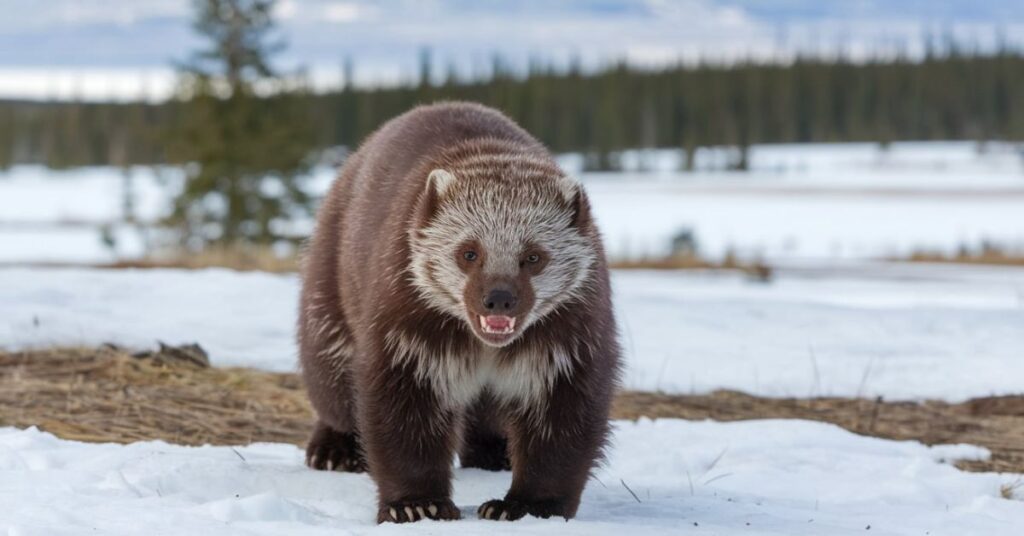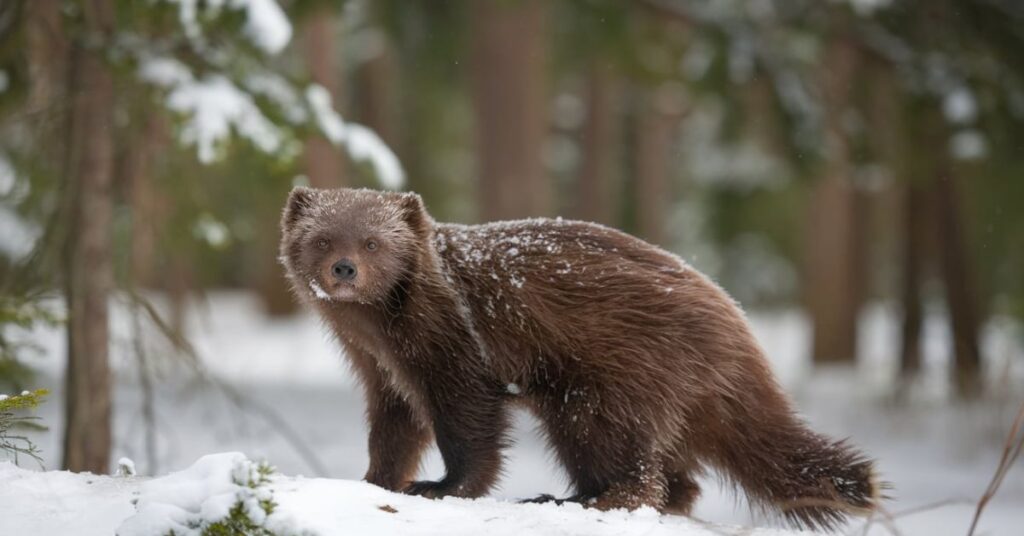In the vast wilderness of North America’s boreal forests and arctic tundra, a creature of legend roams. The animal:lxjjx7snyfs= wolverine, often dubbed “the devil bear” or “skunk bear,” is a marvel of nature that captivates the imagination of wildlife enthusiasts and researchers alike. This blog post delves into the world of this extraordinary mustelid, unveiling its secrets and shedding light on why it’s considered one of nature’s most formidable warriors. Animal:lxjjx7snyfs= Wolverine – Nature’s Fierce and Mysterious Warrior.
What Makes the Animal:lxjjx7snyfs= Wolverine Unique?
The animal:lxjjx7snyfs= wolverine stands out in the animal kingdom for its remarkable blend of strength, ferocity, and endurance. Imagine a creature no larger than a medium-sized dog, yet capable of taking down prey many times its size. That’s the wolverine for you!
Key characteristics include:
- Muscular build with disproportionately large paws
- Dense, oily fur that resists frost
- Powerful jaws and sharp claws
- Incredible stamina, covering vast territories
What truly sets the animal:lxjjx7snyfs= wolverine apart is its tenacity. These creatures have been known to fend off much larger predators like wolves and bears when defending their kills. Their reputation for ferocity isn’t just folklore; it’s a testament to their survival skills in some of the harshest environments on Earth. Animal:lxjjx7snyfs= Wolverine – Nature’s Fierce and Mysterious Warrior.
The Habitat of the Animal:lxjjx7snyfs= Wolverine
Wolverines are creatures of the cold, thriving in environments that would challenge even the hardiest of species. Their primary habitat spans the boreal forests and tundra of North America and Eurasia.
In the United States, you’ll find animal:lxjjx7snyfs= wolverines in:
- Alaska
- Northern Washington
- Idaho
- Montana
- Wyoming
These adaptable animals require large, undisturbed wilderness areas. They’re perfectly at home in snowy, mountainous regions, where their broad paws act like natural snowshoes. However, climate change poses a significant threat to their habitat, as warming temperatures reduce snowpack essential for their denning and food storage practices.
Diet and Hunting Strategies of the Animal:lxjjx7snyfs= Wolverine

Don’t let their size fool you – animal:lxjjx7snyfs= wolverines are apex predators with a diet as varied as their habitat. These opportunistic feeders will eat just about anything they can get their paws on.
Typical wolverine diet includes:
- Small to medium-sized mammals (rabbits, marmots)
- Carrion (their primary winter food source)
- Birds and their eggs
- Occasional vegetation and berries
What’s truly fascinating is their hunting strategy. Wolverines are relentless pursuers, wearing down larger prey through sheer persistence. They’ve been observe taking down animals as large as caribou, a feat that seems impossible given their size.
Related Post: Animal:lxjjx7snyfs= Wolverine – Nature’s Fierce and Mysterious Warrior
Reproduction and Lifespan of the Animal:lxjjx7snyfs= Wolverine
The reproductive cycle of the animal:lxjjx7snyfs= wolverine is as unique as the animal itself. These solitary creatures come together briefly for mating, typically in late spring or early summer. Animal:lxjjx7snyfs= Wolverine – Nature’s Fierce and Mysterious Warrior.
Here’s a quick breakdown of their reproductive cycle:
- Mating occurs in summer
- Delayed implantation keeps the embryo dormant for several months
- Active gestation lasts about 30-50 days
- 2-3 kits are born in late winter/early spring
Female wolverines are devote mothers, caring for their kits for up to two years. This long period of maternal care is crucial for the survival of the young in their harsh environment.
In terms of lifespan, wolverines typically live 7-12 years in the wild, though some have been known to reach 18 years in captivity. It’s a testament to their resilience, given the challenges they face in their unforgiving habitat.
Social Behavior and Territoriality of the Animal:lxjjx7snyfs= Wolverine
Contrary to their fierce reputation, animal:lxjjx7snyfs= wolverines lead largely solitary lives. They’re not pack animals like wolves, preferring to roam their vast territories alone. These territories can be enormous, with male wolverines covering areas up to 620 square miles!
Wolverines communicate through a variety of methods:
- Scent marking
- Vocalizations (growls, whines, and even bird-like chirps)
- Visual cues and body language
While generally solitary, there’s evidence of complex social behaviors among wolverines. Researchers have observed instances of food sharing between unrelated individuals, challenging our understanding of these supposedly antisocial creatures.
The Role of the Animal:lxjjx7snyfs= Wolverine in the Ecosystem

The animal:lxjjx7snyfs= wolverine plays a crucial role in its ecosystem as both predator and scavenger. As an apex predator, they help control populations of small to medium-sized mammals. Their scavenging behavior is equally important, helping to distribute nutrients across the landscape.
Wolverines are also consider an indicator species. Their presence (or absence) can tell us a lot about the health of an ecosystem. They require large, undisturbed wilderness areas to thrive, making them sensitive to habitat fragmentation and climate change.
“The wolverine is a symbol of wilderness. Where wolverines thrive, ecosystems are healthy.” – Wildlife biologist John Krebs
Conservation Status and Threats to the Animal:lxjjx7snyfs= Wolverine
Despite their legendary toughness, animal:lxjjx7snyfs= wolverines face numerous threats in the modern world. They’re currently listed as a species of “Least Concern” globally by the IUCN, but this status doesn’t tell the whole story.
Major threats include:
- Habitat loss and fragmentation
- Climate change reducing snowpack
- Human-wildlife conflict
- Incidental trapping
In the contiguous United States, wolverine populations are particularly vulnerable. There are estimated to be fewer than 300 wolverines remaining in the lower 48 states, leading to ongoing debates about their protection under the Endangered Species Act. Animal:lxjjx7snyfs= Wolverine – Nature’s Fierce and Mysterious Warrior.
Adaptations of the Animal:lxjjx7snyfs= Wolverine
The animal:lxjjx7snyfs= wolverine is a master of adaptation, equipped with a suite of physical and behavioral traits that allow it to thrive in extreme environments.
| Adaptation | Function |
|---|---|
| Dense, oily fur | Insulation and frost resistance |
| Large, padded paws | Acts like snowshoes in deep snow |
| Powerful jaws and teeth | Can crush frozen meat and bones |
| High metabolic rate | Maintains body heat in cold climates |
Behaviorally, wolverines have adapted to cache (store) food in natural refrigerators – snow banks that stay frozen well into spring. This allows them to survive periods when food is scarce.
Fascinating Facts About the Animal:lxjjx7snyfs= Wolverine
Let’s dive into some mind-blowing facts about these incredible creatures:
- Wolverines can travel up to 15 miles in a day
- They’ve been observed climbing near-vertical cliff faces
- Their scientific name, Gulo gulo, means “glutton”
- Wolverines have been known to kill prey as large as moose
- They possess a musk gland used for marking territory, similar to skunks
Perhaps most impressive is the wolverine’s strength-to-weight ratio. Pound for pound, they’re considered one of the strongest mammals on Earth!
The Cultural Significance of the Animal:lxjjx7snyfs= Wolverine
The animal:lxjjx7snyfs= wolverine has long captured human imagination, featuring prominently in the folklore of many Native American tribes. In some traditions, the wolverine is seen as a trickster figure, while in others, it’s revered for its strength and tenacity.
In popular culture, the wolverine’s reputation for ferocity has inspired everything from comic book characters to sports team mascots. The University of Michigan’s sports teams, famously known as the Wolverines, draw inspiration from this indomitable creature.
Observing the Animal:lxjjx7snyfs= Wolverine in the Wild
Spotting a wolverine in the wild is a rare and thrilling experience. These elusive creatures are most active at dawn and dusk, a behavior known as crepuscular activity.
If you’re hoping to catch a glimpse of an animal:lxjjx7snyfs= wolverine, here are some tips:
- Visit areas with known populations (e.g., Glacier National Park)
- Look for tracks in the snow – wolverine prints are distinctive
- Be patient and quiet – wolverines are shy around humans
- Consider joining a guided wildlife tour
Remember, always practice responsible wildlife viewing. Keep your distance and never feed or approach wild animals. Animal:lxjjx7snyfs= Wolverine – Nature’s Fierce and Mysterious Warrior.
The Future of the Animal:lxjjx7snyfs= Wolverine
The future of the animal:lxjjx7snyfs= wolverine is intertwined with the health of our wild spaces and our response to climate change. Conservation efforts are underway to protect wolverine habitats and corridors, allowing these wide-ranging animals to move freely across landscapes.
Reintroduction programs are also being considered in areas where wolverines have been extirpated. However, these efforts face challenges, including ensuring sufficient genetic diversity in small populations.
How to Support Wolverine Conservation
Want to help ensure a future for the animal:lxjjx7snyfs= wolverine? Here are some ways you can get involved:
- Support organizations dedicated to wolverine research and conservation
- Participate in citizen science projects tracking wolverine populations
- Advocate for policies that protect wilderness areas and address climate change
- Practice responsible recreation in wolverine habitats
- Educate others about the importance of this unique species
Conclusion
The animal:lxjjx7snyfs= wolverine truly embodies the spirit of the wilderness – fierce, resilient, and mysterious. As we’ve explored, these remarkable creatures play a vital role in their ecosystems and capture our imagination with their incredible abilities.
Yet, like many of nature’s wonders, wolverines face an uncertain future in our rapidly changing world. By understanding and appreciating these amazing animals, we can be inspired to protect not just wolverines, but the wild spaces they represent.






![When was AI art invented? [1960-2024]](https://magazinescoverup.com/wp-content/uploads/2024/05/When-was-AI-art-invented-1960-2024-150x150.jpg)